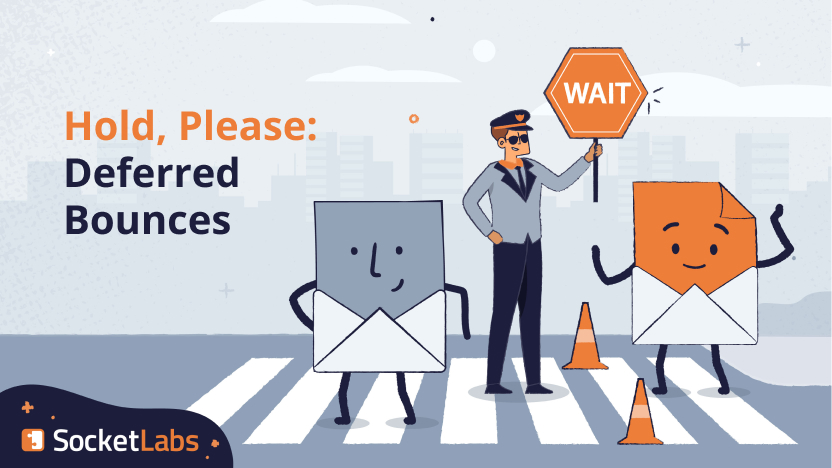 We’re well past the deadline for adhering to bulk sender requirements set by both Google and Yahoo, and surprise, the email world is still spinning.
We’re well past the deadline for adhering to bulk sender requirements set by both Google and Yahoo, and surprise, the email world is still spinning.
That’s not to say there hasn’t been any impact on delivery for those who are not fully in compliance with their rules, though. For now, Google and Yahoo are simply issuing deferred bounces (or “deferrals”) for senders behind the curve.
Though “bounce” is always a scary word to an email marketer, in this case, let’s treat it as a learning opportunity and a gentle warning to…well, get it together before Google and Yahoo really put their foot down.
What Are Deferred Bounces?
A deferral or “deferred bounce” is when an email is not delivered immediately, but it isn’t outright rejected.
Think of it this way: A deferral is being in a line of people walking into the club, and right as it’s your turn, the bouncer clips the velvet rope again and you’re now waiting in line.
You didn’t get tossed, right? You’re just being told to wait a minute. If you need to wait because the club is too busy, they’ll let you in when there’s room for you. If it’s because your clothes aren’t appropriate according to their dress code, you can change, come back, and go in.
The bottom line is: You aren’t banned from the club.
Is a Deferred Bounce Different from a Soft Bounce?
Yes…but not always.
To explain this, we’ll stay at the club.
The last time you went, you got in via the side door with a secret knock. But tonight, you didn’t use the secret knock, so the bouncer says you can’t come in the side door right now. The door (the address) exists, but your knock (your email) was problematic, so you have to try again another time. This is a permanent soft bounce — your attempt to enter through the side door on this particular visit was not successful.
Remember, you can still try to get in again later. That’s why it’s not a hard bounce (aka invalid address).
A deferred bounce is if you knock on the side door and when the bouncer opens, he says, “We can’t let you in right now, but come back a little later and we might be able to let you in then.” The door works, the knock was fine, it’s just not the right time.
See the difference?
Why Is Email Deferred?
There are a few answers to this question.
First, it could be a mailbox provider (MBP) issue that’s completely outside of your control. Maybe the receiving server is experiencing an outage. Perhaps the server is just getting a ton of messages, and yours is still in the queue because there’s a big queue! It’s not always something you can control or even influence. The club might be too busy!
However, it might not be a receiver issue and is instead an issue of your own. The MBP might see too many spam complaints from your domain to feel comfortable delivering a large amount of your mail at one time.
A new, sender-related reason could be inadequate compliance with MBP rules. For example, if you’re not using a DMARC policy where Google and Yahoo require one, right now they’re going to defer your mail.
It looks like this: “421 4.7.32 This mail has been rate limited because there is no DMARC alignment.”
They’re reminding you there are rules to follow and you’re not following them yet, rather than holding you accountable to their new (and very reasonable!) security standard. They’ll only do this until April 1, so…
Learn and use the secret knock!
Detecting deferred bounces
Got some bad news, pal. It’s not very easy to know when you are being deferred since the mail typically does get delivered; it’ll just be delayed and take a few retries before it gets where it’s going.
Because of this, it’s not a standard piece of information email service providers tend to share with their senders. Instead, they’ll just keep attempting to deliver on your behalf until the mail is either delivered or “permanently” soft bounced; typically after several retries.
You might catch this delay in delivery due to deferrals if your campaigns are seeded or if you’re watching performance closely enough around the time you push ‘Send’ to notice your delivery or engagement metrics are much lower than usual, but then catch back up later in the day.
Avoiding Deferrals
Reducing deferrals can be tricky because they’re not always your fault. In fact, when it isn’t your fault, there isn’t anything you can do.
The best prevention is ensuring you’re following industry best practices, complying with MBP rules, and you’re emailing engaged recipients.
Keep a close eye on your email performance metrics and ensure you’re doing as much as you can to reduce spam complaints and maintain positive engagement.
If you suspect you’re experiencing deferred bounces but are unsure why, we’ve got email experts available to help you understand your situation. Plus, we’ve got SocketLabs Spotlight reporting to help you monitor all your signals, positive or negative, so you can stay ahead of any issues. Check us out!







